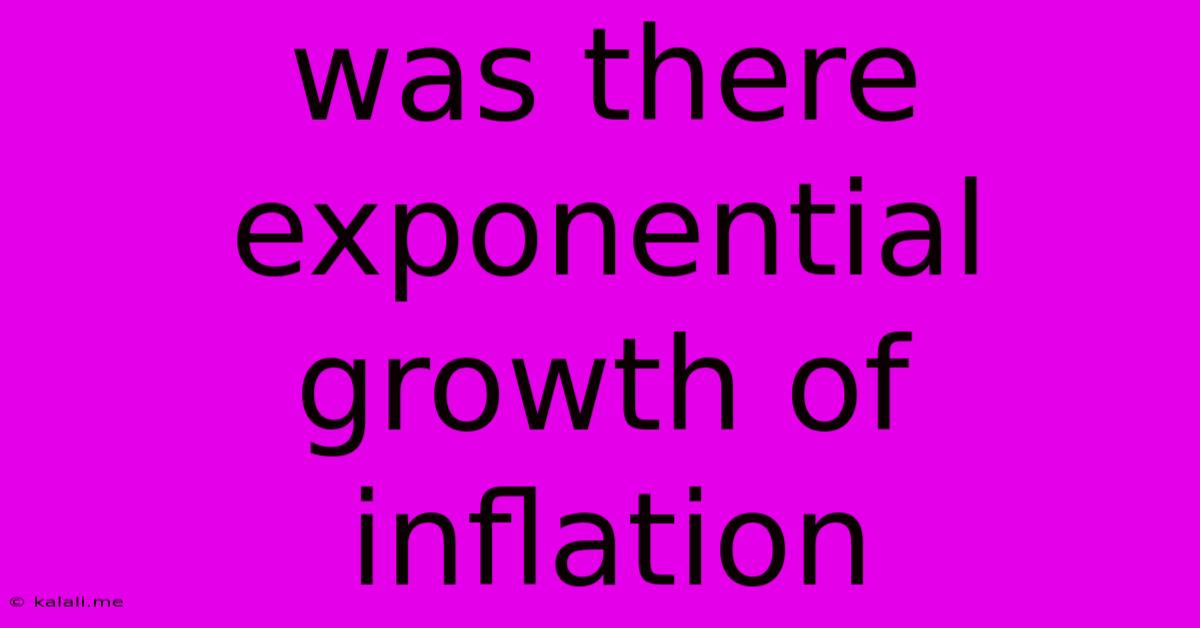Was There Exponential Growth Of Inflation
Kalali
Jun 03, 2025 · 3 min read

Table of Contents
Was There Exponential Growth of Inflation? Understanding Inflationary Trends
Meta Description: Did inflation experience exponential growth? This article explores the dynamics of inflation, differentiating between periods of rapid acceleration and true exponential growth, analyzing historical data and economic factors.
Inflation, the persistent increase in the general price level of goods and services in an economy over a period of time, is a complex phenomenon. While periods of high inflation can feel like exponential growth, true exponential growth—where the rate of increase itself accelerates—is rare in sustained inflationary periods. This article will delve into the nuances of inflation, differentiating between periods of rapid acceleration and true exponential growth.
Defining Exponential Growth
Before examining inflation trends, it's crucial to understand what exponential growth actually means. Exponential growth occurs when a quantity increases at a rate proportional to its current value. This leads to a characteristic J-curve on a graph, with increasingly steeper rises over time. A classic example is compound interest, where interest earned also earns interest.
In the context of inflation, true exponential growth would mean the inflation rate itself is increasing exponentially—not just the price level. For example, if inflation is at 10% this year, next year it would be significantly higher than 20%, perhaps 30%, 50%, or even higher, and this escalating rate would continue.
Historical Examples of High Inflation, But Not Exponential Growth
History offers several examples of hyperinflation, where inflation rates soar to incredibly high levels. The Weimar Republic in the 1920s and Zimbabwe in the 2000s are notorious cases. These periods witnessed incredibly rapid price increases, making everyday transactions extremely difficult. However, even in these extreme cases, a truly exponential pattern rarely persisted over extended periods. While the inflation rate accelerated dramatically, it usually reached a peak and then, often due to government intervention or economic collapse, began to decelerate or stabilize, even if at very high levels.
Factors Affecting Inflation Rates
Various economic factors contribute to inflation. These include:
- Demand-pull inflation: Increased demand for goods and services exceeding supply.
- Cost-push inflation: Rising production costs, such as wages or raw materials, leading to higher prices.
- Built-in inflation: Wage increases based on past inflation expectations, creating a self-perpetuating cycle.
- Monetary policy: Government actions influencing the money supply; excessive money printing can be inflationary.
- Supply shocks: Sudden disruptions to the supply chain, like natural disasters or geopolitical events.
These factors interact in complex ways, making it difficult to predict inflation with complete accuracy. While some periods might exhibit rapid acceleration, sustained exponential growth is rarely observed. Instead, inflation rates usually fluctuate, influenced by shifts in these underlying economic forces.
Analyzing Inflation Data: Looking for the Telltale Signs
To determine whether inflation exhibits exponential growth, analyzing inflation data over time is crucial. Examining charts showing inflation rates year over year will reveal whether the rate of increase is proportional to its current value, a key characteristic of exponential growth. While you might observe periods of rapid acceleration, a true exponential curve is unlikely to be sustained for long periods.
Conclusion: Rapid Acceleration, Not Exponential Growth
While periods of hyperinflation can certainly feel like exponential growth, a strict mathematical definition of exponential growth is rarely observed in sustained inflationary periods. While inflation rates can accelerate dramatically under specific circumstances, various economic factors and countervailing forces generally prevent the sustained exponential increase of the inflation rate itself. Therefore, it's more accurate to describe periods of high inflation as exhibiting rapid acceleration rather than true exponential growth. Understanding this distinction is vital for accurate economic analysis and informed policymaking.
Latest Posts
Latest Posts
-
Why Is Mirror Modifier Not Setting To Mirror From Center
Jun 05, 2025
-
How To Loosen Lug Nuts On Tire
Jun 05, 2025
-
What Is A Spell In Magic The Gathering
Jun 05, 2025
-
Nest Thermostat Ac Fan Speed Really Slow
Jun 05, 2025
-
Fallout 4 Mark Power Armor As Owned
Jun 05, 2025
Related Post
Thank you for visiting our website which covers about Was There Exponential Growth Of Inflation . We hope the information provided has been useful to you. Feel free to contact us if you have any questions or need further assistance. See you next time and don't miss to bookmark.